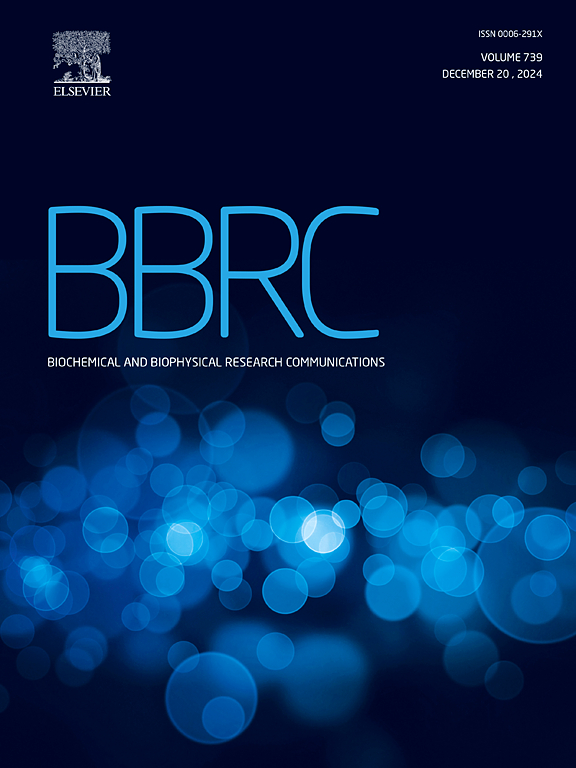Twisting and untwisting of actin and tropomyosin filaments may be involved in the molecular mechanism of muscle contraction
IF 2.5
3区 生物学
Q3 BIOCHEMISTRY & MOLECULAR BIOLOGY
Biochemical and biophysical research communications
Pub Date : 2025-05-26
DOI:10.1016/j.bbrc.2025.152080
引用次数: 0
Abstract
Polarized fluorescence microscopy in “ghost” muscle fibers containing F-actin, tropomyosin, and myosin heads labeled with FITC-phalloidin, 5-IAF, and 1,5-IAEDANS probes, respectively, provided new insights into the molecular mechanisms of muscle contraction. Simulation of different stages of muscle contraction revealed significant changes in probe orientation and mobility, as well as variations in the bending stiffness of actin and tropomyosin filaments. Fluorescence analysis showed that in the AM∗•ATP state, myosin heads deviate from the axis of actin and weakly interact with thin filaments. Actin filaments exhibit excessive twisting, while tropomyosin filaments untwist. This is accompanied by a 115 % increase in actin filament stiffness and a 32 % increase in tropomyosin filament stiffness. The transition to the AM•ADP state aligns the myosin heads and induces actin untwisting. The release of inorganic phosphate reduces actin stiffness by 45 % and increases tropomyosin stiffness by 9 %. We propose that the untwisting of supertwisted actin filaments, combined with myosin head tilting towards actin and increased tropomyosin twist and stiffness, causes thin filaments to slide along thick filaments. The synchronized sliding of thin filaments relative to thick filaments ultimately generates the mechanical force that drives muscle contraction.
肌动蛋白和原肌球蛋白丝的扭转和解扭可能参与了肌肉收缩的分子机制
分别用FITC-phalloidin、5-IAF和1,5- iaedans探针标记含有F-actin、原肌球蛋白和肌球蛋白头的“鬼”肌纤维的极化荧光显微镜,为肌肉收缩的分子机制提供了新的见解。模拟肌肉收缩的不同阶段,发现探针的方向和移动能力发生了显著变化,肌动蛋白和原肌球蛋白丝的弯曲刚度也发生了变化。荧光分析表明,在AM *•ATP状态下,肌凝蛋白头部偏离肌动蛋白轴,与细丝发生弱相互作用。肌动蛋白丝过度扭曲,而原肌凝蛋白丝不扭曲。同时肌动蛋白丝刚度增加115%,原肌凝蛋白丝刚度增加32%。AM•ADP状态的转变使肌凝蛋白头部对齐并诱导肌动蛋白解扭。无机磷酸盐的释放使肌动蛋白硬度降低45%,使原肌凝蛋白硬度增加9%。我们认为,超扭曲的肌动蛋白丝的解扭,加上肌凝蛋白头部向肌动蛋白倾斜以及原肌凝蛋白捻度和刚度的增加,导致细丝沿着粗丝滑动。细纤维相对于粗纤维的同步滑动最终产生驱动肌肉收缩的机械力。
本文章由计算机程序翻译,如有差异,请以英文原文为准。
求助全文
约1分钟内获得全文
求助全文
来源期刊
CiteScore
6.10
自引率
0.00%
发文量
1400
审稿时长
14 days
期刊介绍:
Biochemical and Biophysical Research Communications is the premier international journal devoted to the very rapid dissemination of timely and significant experimental results in diverse fields of biological research. The development of the "Breakthroughs and Views" section brings the minireview format to the journal, and issues often contain collections of special interest manuscripts. BBRC is published weekly (52 issues/year).Research Areas now include: Biochemistry; biophysics; cell biology; developmental biology; immunology
; molecular biology; neurobiology; plant biology and proteomics

 求助内容:
求助内容: 应助结果提醒方式:
应助结果提醒方式:


